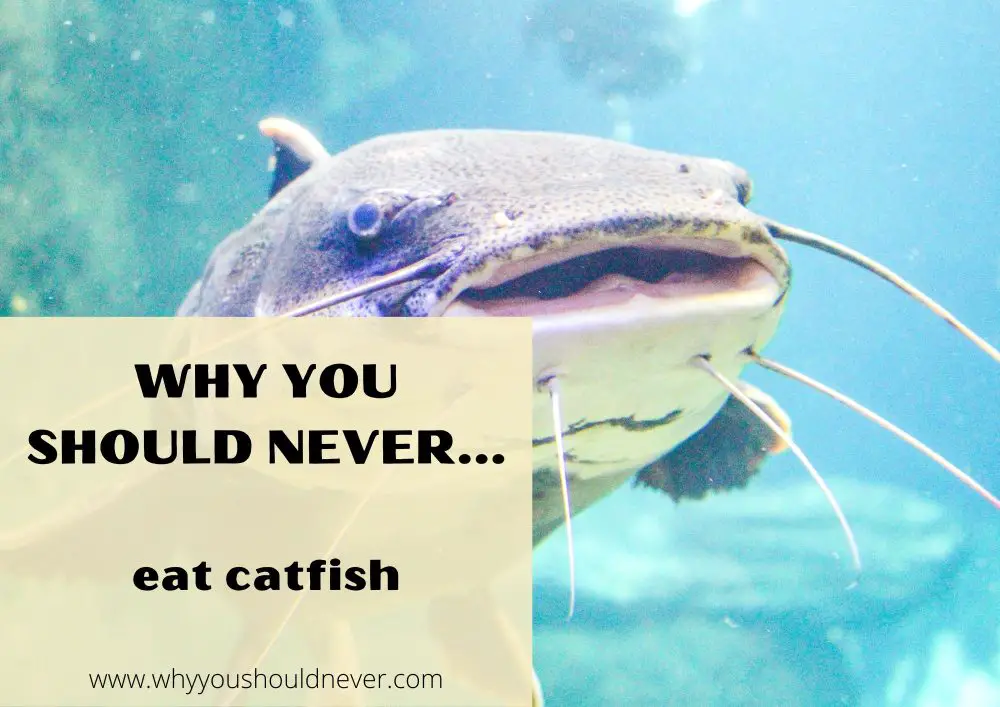![]()
Why You Should Never Eat Catfish
Catfish is a popular dish in the Southern United States, often fried and served with hush puppies and coleslaw. This bottom-dwelling fish is also a staple in many cuisines around the world.
If you’re a catfish-loving foodie, you’ve probably found yourself talking up this tasty, relatively inexpensive source of protein from time to time. But have you ever stopped to think about where that catfish came from and what it was eating before it landed on your plate?
I’m guessing not.
Luckily, I’m here to tell you all about why eating catfish is a bad idea.
8 reasons why you shouldn’t eat catfish
1. Catfish are bottom feeders
Catfish are notorious for being bottom feeders, scavenging along the river or lake bed and consuming whatever they come across. This means that they’re exposed to a wide range of pollutants, including chemicals and heavy metals from industrial runoff, agricultural fertilizers and pesticides, and sewage.
As these toxins accumulate in their bodies over time, eating catfish can expose you to harmful contaminants that may cause health problems such as cancer or other chronic diseases.
2. Catfish can carry harmful bacteria
In addition to their exposure to pollutants, catfish are also prone to carrying harmful bacteria such as E.coli and salmonella. This is because they often live in warm, stagnant waters that provide an ideal breeding ground for these microorganisms.
Consuming contaminated catfish can lead to food poisoning symptoms such as diarrhea, nausea, and vomiting.
3. Catfish may contain parasites
Another issue with eating catfish is the risk of parasitic infections. Some species of catfish, particularly those found in warm waters, can be infected with parasites that can cause serious health problems such as liver damage and even death.
While cooking fish thoroughly can help kill off some types of parasites, it’s not foolproof. And for people who eat raw or undercooked catfish dishes like ceviche or sushi rolls containing catfish, the risk is even higher.
4. Catfish farming practices are often questionable
We should always be concerned about the ethical and environmental implications of our food choices. Unfortunately, catfish farming practices are often questionable.
Many catfish farms use overcrowded conditions and high amounts of antibiotics to keep their fish healthy in these unnatural environments. This can lead to the development of antibiotic-resistant bacteria that can be harmful to both humans and animals.
In addition, some farmers may use questionable methods for feeding their catfish, such as using animal byproducts or other waste products that can further contaminate the fish and the environment.
5. Catfish are not a sustainable food source
Many catfish farms use unsustainable practices that involve clearing land, using large amounts of water and energy, and releasing waste products into nearby waterways. This puts a strain on our resources and can cause long-term damage to the environment.
6. Catfish may not be what you think they are
If you’re dining out and see catfish on the menu, there’s a chance that what you’re being served isn’t actually catfish at all.
A study by Oceana found that over one-fifth of seafood samples in the US were mislabeled, with cheaper or less desirable fish being sold as more expensive species. This happens with catfish, too, where the cheaper swai or basa fish is often sold as catfish.
Not only is this misleading for consumers, but it can also have serious health implications. Swai and basa are usually raised in Southeast Asia, where they may be exposed to even more pollutants than American catfish.
7. Calorie-dense meals
Though the catfish itself, like most fish, is low in calories, the traditional Southern-style preparation of catfish can be high in calories and unhealthy fats.
It’s standard practice to deep-fry catfish in a batter made with flour, cornmeal, and other ingredients that add to the calorie and fat count. And when served alongside popular sides like hush puppies, French fires, and coleslaw, you’re looking at a meal that’s high in saturated fats, sodium, and calories.
8. There are better seafood protein sources
If protein is what you’re looking for, there are plenty of other seafood options that are more sustainable and less risky to your health. Some great alternatives to catfish include salmon, trout, sardines, and mussels.
These fish are all high in omega-3 fatty acids, which have been linked to a range of health benefits including lower risk of heart disease and improved brain function.
Plus, many of these species are farmed or caught using more sustainable practices than catfish. By choosing these options over catfish, you’re not only doing your body a favor, but also supporting more responsible fishing and farming practices.
Catfish is indeed tasty, protein-rich, relatively cheap, all that good stuff, but it comes with its share of risks and ethical concerns.
From pollution and bacteria to parasites and questionable farming practices, there are plenty of reasons why you might want stay away from it, or at the very least limit your consumption.
But who am I to tell you what to do? All I can do is provide you with the facts and let you make your own informed decision, which is what I hope I’ve done here.
